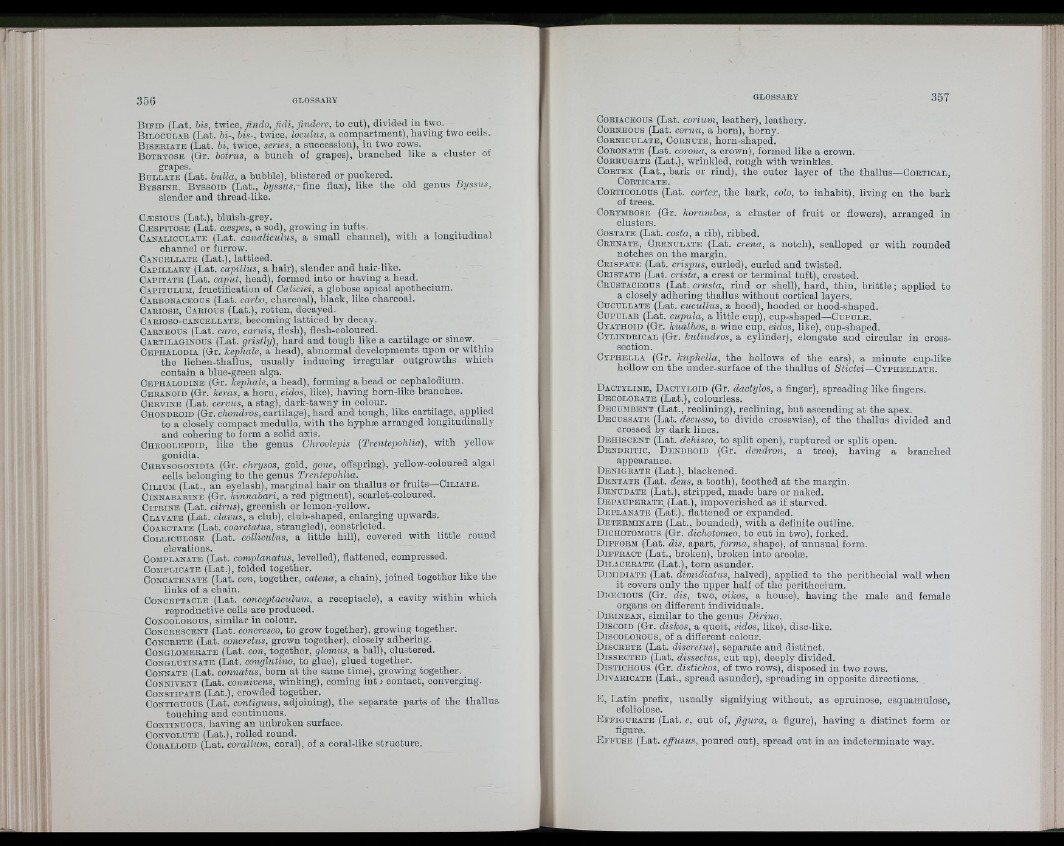
B if id (L a t. bis, twice, findo, fi,di, findere, to cut), divided in two.
B ilooular (Lat. bi-, bis-, twice, loculus, a compartment), having two cells.
B iseriate (Lat. hi, twice, series, a succession), in two rows.
B otryose (Gr. botrus, a bunch of grapes), branched like a cluster of
grapes.
B úllate (Lat. bulla, a bubble), blistered or puckered.
B yssinb, B yssoid (L at., byssus, fine flax), like th e old genus Byssus,
slender an d thread-like.
Cæsious (Lat.), bluish-grey.
Oæspitose (Lat. ccBspes, a sod), growing in tu fts .
Canaliculate (Lat. canaliculus, a small channel), with a longitudinal
channel or furrow.
Cancbllate (Lat.), latticed.
Capillary (Lat. capillus, a hair), slender and hair-like.
Capitate (Lat. caput, head), formed into or having a head.
Capitulum, fructification of Oaliciei, a globose apical apothecium.
Carbonaceous (Lat. carho, charcoal), black, like charcoal.
Carióse, Carious (Lat.), rotten, decayed.
Cabioso-canoellate, becoming la ttic e d by decay.
Carneous (Lat. caro, carnis, flesh), flesh-coloured.
Cartilaginous (Lat. gristly), hard and tough like a cartilage or sinew.
Cephalodia (Gr. kephale, a head), abnormal developments upon or within
the lichen-thallus, usually inducing irregular outgrowths which
contain a blue-green alga.
Cbphalodine (Gr. kephale, a head), forming a head or cephalodium.
Cebanoid (Gr. keras, a horn, eidos, like), having horn-like branches.
Cervine (Lat. cervus, a stag), dark-tawny iu colour.
Chondroid (Gr. chondros, cartilage), hard and tough, like cartilage, applied
to a closely compact medulla, with the hyphæ arranged longitudinally
and cohering to form a solid axis.
Chroolepoid, like the genus Chroolepis (Trentepohlia), with yellow
gonidia.
Chbysogonidia (Gr. chrysos, gold, gone, offspring), yellow-coloured algal
cells belonging to the genus Trentepohlia.
CiLiUM (Lat., an eyelash), marginal hair on thallus or fruits—Cil ia t e .
CiNNABABiNB (Gr. kinnabari, a red pigment), scarlet-coloured.
Citr in e (Lat. citrus), greenish or lemon-yellow.
Clavate (Lat. clavus, a club), club-shaped, enlarging upwards.
OoARCTATB (Lat. coarctatus, strangled), constricted.
Colliodlose (L at. colliculus, a little hill), covered w ith little ro u n d
elevatioQS.
COMPLANATE (Lat. complanatus, levelled), flattened, compressed.
Complicate (Lat.), folded together.
Concatenate (Lat. con, to g e th e r, catena, a chain), joined to g e th e r like th©
lin k s of a chain.
C O N C B P T A O L B (Lat. conceptaculum, a receptacle), a cavity withm which
reproductive cells are produced.
Concolorous, sim ila r in colour.
Concrescent (Lat. concresoo, to grow together), growing together.
Concrete (Lat. concretus, grown together), closely adhering.
Conglomerate (Lat. con, together, glomus, a ball), clustered.
Conglutínate (Lat. conglutino, to glue), glued together.
Connate (Lat. connatus, born at the same time), growing together. _
Connivent (Lat. connivens, winking), coming in ti contact, converging.
Constipate (Lat.), crowded together.
Contiguous (Lat. contiguus, adjoining), the separate parts of the thallus
touching and continuous.
Continuous, having an u n b ro k en surface.
Convolute (Lat.), rolled round.
C oR A L LO iD (Lat. corallum, coral), of a coral-like structure.
Coriaceous (Lat. corium, leather), leathery.
Corneous (Lat. cornu, a horn), horny.
Corniculate, Cobnute, horn-shaped.
Coronate (Lat. corona, a crov/n), formed like a crown.
Corrugate (Lat.), wrinkled, rough with wrinkles.
Cortex (Lat.,.bark or rind), the outer layer of the thallus—Cortical,
Corticate.
Corticolous (Lat. cortex, the bark, colo, to inhabit), living on the bark
of trees.
Corymbose (Gr. korumbos, a cluster of fruit or flowers), arranged iu
clusters.
Costate (Lat. costa, a rib), ribbed.
Crenate, Gbbnulatb (Lat. crena, a notch), scalloped or with rounded
notches on the margin.
Cbispate (Lat. crispus, curled), curled and twisted.
Cristate (Lat. crista, a crest or terminal tuft), crested.
Crustaceous (Lat. crusta, rind or shell), hard, thin, brittle; applied to
a closely adhering thallus without cortical layers.
Cu cuL LATB (Lat. cucullus, a hood), hooded or hood-shaped.
Cupular (Lat. cupula, a little cup), cup-shaped—Gu pu l e .
Gyathoid (Gr. kuathos, a wine cup, eidos, like), cup-shaped.
Cylindrical (Gr. kuliiulros, a cylinder), elongate and circular iu cross-
section.
Cyphblla (Gr. kuphella, the hollows of the ears), a minute cup-like
hollow on the under-surface of the thallus of Stictei—Cy phellate.
D actylinb, D actyloid (Gr. dactylos, a finger), spreading like fingers.
Deoolobatb (Lat.), colourless.
D ecumbent (Lat., reclining), reclining, but ascending at the apex.
Decussate (Lat. clecusso, to divide crosswise), of the thallus divided and
crossed by dark lines.
D ehiscent (Lat. dehisco, to split open), ruptured or split open.
Dendritic, D endroid (Gr. dendron, a tree), having a branched
appearance.
Denigrate (Lat.), blackened.
Dentate (Lat. dens, a tooth), toothed at the margin.
D enudate (Lat.), stripped, made bare or naked.
D epauperate. (Lat.), impoverished as if starved.
Deplanatb (Lat.), flattened or expanded.
D eterminate (Lat., bounded), with a definite outline.
Dichotomous (Gr. dichotomeo, to cut in two), forked.
Difform (Lat. dis, apart, forma, shape), of unusual form.
D iffract (Lat., broken), broken into areolæ.
Dilaceratb (Lat.), torn asunder.
Dimidiate (Lat. dimidiatus, halved), applied to the peritheciai wall when
it covers only the upper half of the perithecium.
D ioeoious (Gr. dis, two, oikos, a house), having the male and female
organs on different individuals.
D irinean, similar to the genus Dirina.
Discoid (Gr. diskos, a quoit, eidos, like), disc-like.
Discolorous, of a difierent colour.
Discrete (Lat. discrctus), separate and distinct.
Dissected (Lat. dissectus, cut up), deeply divided.
Distichous (Gr. distichos, of two rows), disposed in two rows.
D ivaricate (Lat., spread asunder), spreading in opposite directions.
K, Latin prefix, usually signifying without, as epruinose, esquamulose,
efoliolose.
E ffigurate (Lat. e, out of, figura, a figure), having a distinct form or
figure.
E f fu se (Lat. effusus, poured out), spread out in an indeterminate way.